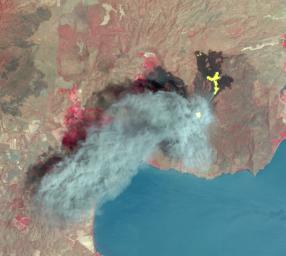In Dec. 2015, one of Nicaragua's largest volcanoes, Momotombo, erupted for the first time since 1905. Continued activity at the end of February and into March 2016 produced large ash columns and pyroclastic (superheated ash-and-block) flows. On March 2, 2016, the Advanced Spaceborne Thermal Emission and Reflection Radiometer (ASTER) instrument aboard NASA's Terra spacecraft captured the volcano's eruptive activity during the day with its visible bands, and the previous night with its thermal infrared bands. The composite image shows a large blue-gray ash cloud covering the volcano's summit. The superimposed night data show the hot flows (in yellow) on the northeast flank, and the active summit crater in white. The data cover an area of 10.6 by 11.2 miles (17 by 18 kilometers), and are located at 12.7 degrees north, 86.6 degrees east.
With its 14 spectral bands from the visible to the thermal infrared wavelength region and its high spatial resolution of 15 to 90 meters (about 50 to 300 feet), ASTER images Earth to map and monitor the changing surface of our planet. ASTER is one of five Earth-observing instruments launched Dec. 18, 1999, on Terra. The instrument was built by Japan's Ministry of Economy, Trade and Industry. A joint U.S./Japan science team is responsible for validation and calibration of the instrument and data products.
The broad spectral coverage and high spectral resolution of ASTER provides scientists in numerous disciplines with critical information for surface mapping and monitoring of dynamic conditions and temporal change. Example applications are: monitoring glacial advances and retreats; monitoring potentially active volcanoes; identifying crop stress; determining cloud morphology and physical properties; wetlands evaluation; thermal pollution monitoring; coral reef degradation; surface temperature mapping of soils and geology; and measuring surface heat balance.
The U.S. science team is located at NASA's Jet Propulsion Laboratory, Pasadena, Calif. The Terra mission is part of NASA's Science Mission Directorate, Washington, D.C.
More information about ASTER is available at http://asterweb.jpl.nasa.gov/.

 Planetary Data System
Planetary Data System












